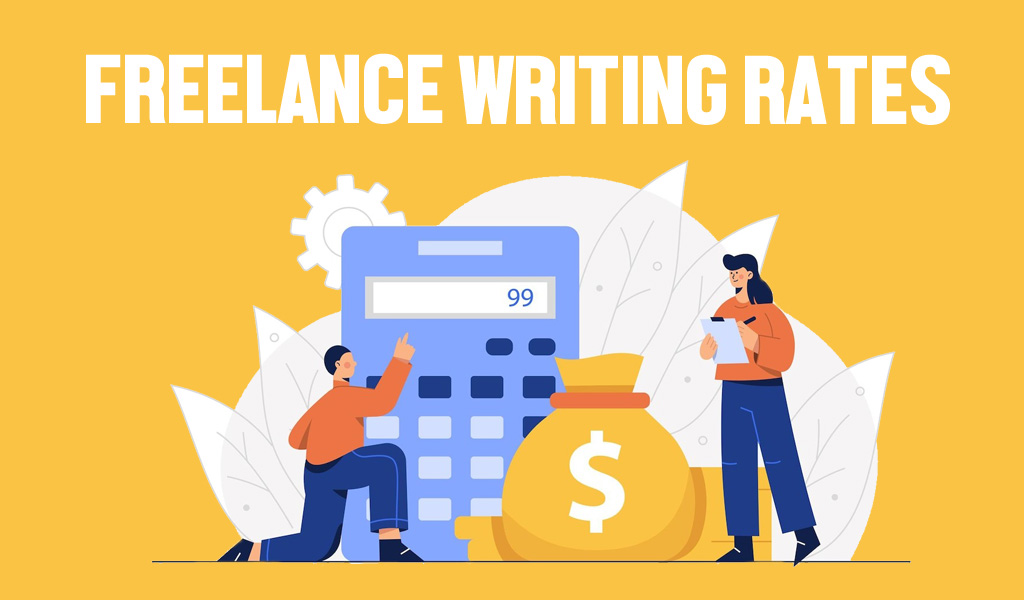Freelance writing is a flexible and rewarding career that allows you to work from anywhere, set your own schedule, and pursue your passion. But how do you know how much to charge for your writing services? How do you price your work for maximum income and client satisfaction? How do you find the sweet spot for success?

In this ultimate guide, we will explore freelance writer rates and how to price your services in different niches, content types, and markets. We will also share some tips and best practices on how to negotiate your rates, raise your rates, and avoid common pitfalls. Whether you are a beginner or an experienced freelance writer, this guide will help you understand freelance writer rates and how to make the most of them.
What are Freelance Writer Rates?
Freelance writer rates are the amount of money that freelance writers charge for their writing services. They can be expressed in different ways, such as:
Per word
This is the most common way of charging for freelance writing, especially for online content such as blog posts, articles, and web copy. The rate per word depends on the niche, content type, quality, and complexity of the writing. For example, a freelance writer may charge $0.10 per word for a basic blog post, $0.25 per word for a technical article, or $0.50 per word for a sales copy.
Per hour
This is another way of charging for freelance writing, especially for projects that require a lot of research, editing, or revisions. The rate per hour depends on the experience, skill level, and reputation of the writer. For example, a freelance writer may charge $25 per hour for a simple editing job, $50 per hour for a complex research project, or $100 per hour for a high-profile client.
Per project
This is a way of charging for freelance writing that involves a fixed fee for a specific project or deliverable. The rate per project depends on the scope, length, and difficulty of the project. For example, a freelance writer may charge $500 for a 2,000-word white paper, $1,000 for a 5-page website copy, or $2,000 for a 10-page eBook.
Per page
This is a way of charging for freelance writing that involves a fixed fee per page of writing. The rate per page depends on the format, layout, and design of the page. For example, a freelance writer may charge $50 per page for a standard letter-sized document with 12-point font and 1-inch margins, $100 per page for a brochure with graphics and images, or $200 per page for a magazine article with photos and captions.
Retainer
This is a way of charging for freelance writing that involves a monthly or quarterly fee for ongoing work or services. The retainer fee depends on the type, volume, and frequency of the work or services. For example, a freelance writer may charge $1,000 per month for writing four blog posts per week, $2,000 per quarter for writing one newsletter per month, or $5,000 per year for writing one annual report.
How to Choose Your Freelance Writing Niche
One of the most important factors that affect your freelance writer rates is your niche. Your niche is the specific topic or industry that you write about. For example, some popular niches are health, finance, technology, education, travel, and lifestyle.
How to Choose your niche can help you:
- Attract your ideal clients who are looking for experts in your niche
- Stand out from the competition who are generalists or write in different niches
- Increase your credibility and authority as a writer in your niche
- Charge higher rates as a specialist who can provide more value and quality in your niche
But how do you choose your niche? Here are some tips to help you:
- Follow your passion: Choose a niche that you are genuinely interested in and passionate about. This will make your writing more enjoyable and engaging.
- Leverage your expertise: Choose a niche that you have some knowledge or experience in. This will make your writing more credible and authoritative.
- Research the market: Choose a niche that has enough demand and potential clients. This will make your writing more profitable and sustainable.
- Narrow down your focus: Choose a niche that is not too broad or too narrow. This will make your writing more relevant and specific.
Some examples of niches that are too broad are:
- Health
- Finance
- Technology
Some examples of niches that are too narrow are:
- Keto diet recipes
- Cryptocurrency trading tips
- Artificial intelligence trends
Some examples of niches that are just right are:
- Mental health
- Personal finance
- Software development
How to Price Your Freelance Writing Services
Once you have chosen your niche, the next step is to price your freelance writing services. This can be challenging, especially if you are new to freelance writing or unsure of your value. Here are some steps to help you:
Research the market
Find out the average rates for your niche, content type, and market. You can use online resources such as PayScale, Glassdoor, Freelance Writing, and Upwork to get an idea of the range and median of freelance writer rates. You can also ask other freelance writers in your niche or network for their rates and experiences.
Assess your skills
Evaluate your skills, experience, and portfolio as a freelance writer. Consider your writing quality, speed, style, and versatility. Also, consider your education, training, certifications, and awards that are relevant to your niche and content type.
Determine your goals
Set your income goals and expenses as a freelance writer. Consider how much you want to earn per month, per year, or per project. Also, consider how much you need to spend on taxes, insurance, equipment, software, marketing, and other business expenses.
Calculate your rates
Based on your research, skills, and goals, calculate your rates for different content types and projects. You can use online tools such as Freelance Rate Calculator, Bonsai Freelance Rate Explorer, and ClearVoice Content Rate Calculator to help you. You can also use different methods such as cost-plus pricing, value-based pricing, and market-based pricing to determine your rates.
Test and adjust your rates
Try out your rates with different clients and projects. See how they respond and how you perform. If you get too many rejections or complaints, you may need to lower your rates. If you get too many acceptances or praises, you may need to raise your rates. If you get a balanced mix of feedback and results, you may have found your sweet spot.
How to Negotiate Your Freelance Writer Rates
Sometimes, you may encounter clients who want to negotiate your freelance writer rates. This can be intimidating or frustrating, especially if you are not confident or comfortable with negotiating. Here are some tips to help you:
Be prepared
Before you enter a negotiation, do your homework. Know your value, your minimum rate, and your ideal rate. Also, know the client’s budget, needs, and expectations.
Be professional
During the negotiation, be polite, respectful, and confident. Don’t be rude, defensive, or arrogant. Use clear and positive language and tone.
Be flexible
During the negotiation, be willing to compromise and offer alternatives. Don’t be rigid or stubborn. Consider different options such as discounts, bonuses, referrals, testimonials, or long-term contracts.
Be assertive
During the negotiation, be firm and confident in your value and quality. Don’t be timid or apologetic. Stand up for yourself and your work.
Be realistic
During the negotiation, be realistic and reasonable in your expectations and demands. Don’t be greedy or unrealistic. Know when to accept or decline an offer.
How to Raise Your Freelance Writer Rates
As you grow and improve as a freelance writer, you may want to raise your freelance writer rates. This can help you increase your income, attract better clients, and reflect your value and quality. Here are some tips to help you:
Track your progress
Keep track of your achievements and results as a freelance writer. Record your testimonials, reviews, ratings, referrals, awards, publications, and metrics that show the impact of your writing on the client’s goals.
Update your portfolio
Update your portfolio with your best and latest work samples that showcase your skills and expertise in your niche and content type. Make sure your portfolio is relevant, organized, and impressive.
Educate yourself
Educate yourself with the latest trends and best practices in your niche and content type. Read books, blogs, podcasts, newsletters, courses, webinars, workshops, conferences, and other resources that can help you learn new skills and knowledge.
Market yourself
Market yourself with a strong personal brand that highlights your value proposition and unique selling point as a freelance writer. Use social media platforms such as LinkedIn, Twitter, Facebook, Instagram, YouTube, Medium, Quora, Reddit, etc., to showcase your work samples and connect with potential clients.
Communicate with clients
Communicate with existing clients about raising your rates in advance. Explain the reasons for raising your rates such as increased demand, quality improvement, cost of living adjustment, or market changes. Provide evidence of your value and results such as testimonials, reviews, ratings, referrals, awards, publications, and metrics. Offer incentives or discounts for loyal or long-term clients
How to Avoid Common Pitfalls of Freelance Writer Rates
As a freelance writer, you may face some challenges and difficulties with your freelance writer rates. Here are some common pitfalls to avoid and how to overcome them:
Undercharging
This is when you charge too low for your writing services, either because you don’t know your value, you are afraid of losing clients, or you are competing with low-cost writers. Undercharging can hurt your income, reputation, and motivation. To avoid undercharging, do your market research, assess your skills, set your goals, calculate your rates, and be confident in your value and quality.
Overcharging
This is when you charge too high for your writing services, either because you are overconfident, greedy, or unrealistic. Overcharging can scare away potential clients, damage your credibility, and limit your opportunities. To avoid overcharging, be realistic, reasonable, and flexible in your expectations and demands. Know your value, but also know your limits and the market conditions.
Scope creep
This is when the client asks for more work or changes than what was originally agreed upon, without paying extra or adjusting the deadline. Scope creep can increase your workload, stress, and frustration. To avoid scope creep, have a clear and detailed contract that outlines the scope, deliverables, timeline, and payment terms of the project. Also, communicate with the client regularly and set boundaries and expectations.
Late payment
This is when the client delays or fails to pay you for your writing services, either because they are dishonest, disorganized, or dissatisfied. Late payment can affect your cash flow, budget, and financial security. To avoid late payment, have a clear and detailed invoice that specifies the payment method, amount, and due date of the project. Also, use online payment platforms such as PayPal, Stripe, or TransferWise that offer security and convenience for both parties.
Burnout
This is when you experience physical, mental, or emotional exhaustion from working too much or too hard as a freelance writer. Burnout can affect your health, happiness, and productivity. To avoid burnout, take care of yourself and your well-being. Set a healthy and realistic work schedule that allows you to have enough rest, sleep, exercise, and leisure. Also, outsource or delegate some of your tasks or projects to other freelance writers or assistants if possible.
Conclusion
Freelance writer rates are an important aspect of freelance writing that can determine your success and satisfaction as a freelance writer. By following this ultimate guide, you can understand freelance writer rates and how to price your services for maximum income and client satisfaction. You can also learn how to negotiate your rates, raise your rates, and avoid common pitfalls of freelance writer rates.
Remember, there is no one-size-fits-all formula for freelance writer rates. You have to find the sweet spot that works for you, your niche, your content type, and your market. You also have to be flexible and adaptable to changing circumstances and opportunities.
We hope this guide has helped you understand freelance writer rates and how to make the most of them. If you have any questions or feedback, please feel free to contact us.



